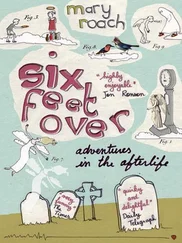After Ed White’s spacewalk, reports of space euphoria were rare, and soon the psychologists stopped worrying. They had something new to worry on: “EVA height vertigo.” (EVA is short for “extravehicular activity,” meaning spacewalking.) The image of Earth rushing by some 200 miles below can cause paralyzing fear. Mir astronaut Jerry Linenger wrote in his memoir about the “dreadful and persistent” feeling that he was “plummeting earthward…at ten times or a hundred times faster” than he’d experienced during parachute free falls. Which he was. (The difference, of course, is that the astronaut is falling in a huge circle around Earth and doesn’t hit the ground.)
“White-knuckled, I gripped the handrail…,” wrote Linenger of his agonized moments on the end of Mir’s 50-foot telescoping arm, “forcing myself to keep my eyes open and not scream.” I once listened to a Hamilton Sundstrand suit engineer tell the story of an unnamed spacewalker exiting the hatch and then turning to wrap both spacesuited arms around a colleague’s legs.
Charles Oman, a space-motion-sickness and vertigo expert at the National Space Biomedical Research Institute, points out that EVA height vertigo is not a phobia, but a normal response to the novel and terrifying cognitive reality of falling through space at 17,500 miles per hour. Be that as it may, astronauts are disinclined to share. “There’s a big reporting problem,” says Oman.
Astronauts train for spacewalks by putting on their EVA suits and rehearsing their moves while floating in a giant indoor pool called a neutral buoyancy tank. Floating in water is not exactly like floating in space, but it’s a decent simulation for the purposes of practicing tasks and gaining familiarity with the outside of your spacecraft. (Mock-ups of parts of the ISS exterior lie submerged like a shipwreck on the floor of the pool in Houston.) But the training does nothing to prevent EVA height vertigo. Virtual reality training may help to a degree, but in the end, you can’t effectively “sim” the sensation of free fall in space. To get a very mild sense of what it’s like, climb a telephone pole (while wearing a safety harness), and then try to stand up on the flat, pie-sized top of the pole—as self-empowerment seminar attendees and phone company applicants are sometimes made to do. “Phone companies lose about a third of their trainees in the first few weeks,” says Oman.
THESE DAYS, THE PSYCHOLOGISTS have turned their attention to Mars. The breakaway effect appears to have been repackaged as “earth-out-of-view phenomenon”:
In the history of human beings, no one has ever been in a situation when Mother Earth, and all of her associated nurturing and comforting aspects… has been reduced to insignificance in the sky…. It seems possible that it will induce some state of internal uncoupling from the Earth. Such a state might be associated with a broad range of individual maladaptive responses, including anxiety and depressive reactions, suicidal intention, or even psychotic symptoms such as hallucinations or delusions. In addition, a partial or complete loss of commitment to the usual (Earth-bound) system of values and behavioral norms may occur.
The passage is from the book Space Psychology and Psychiatry . I read it aloud to cosmonaut Sergei Krikalyov. Krikalyov is a veteran of six missions and now the head of training at the Yuri Gagarin Cosmonaut Training Center in Star City, the town outside Moscow where cosmonauts and other Russian space professionals and their families live and work.
Krikalyov isn’t a man who snorts, but his response implied one: “Psychologists need to write papers.” He told me that in the early days of the railway system, there was concern that people would be driven insane by the sight of trees and fields rushing past through the windows. “There was suggestion to build fences on both sides of railroad, otherwise the passengers are going to be crazy. And no one was talking about this except psychologists.”
Every now and then, you do come across astronauts who describe an anxiety unique to space. It’s not fear (though apparently astrophobia, [12] One self-help phobia Web site helpfully reassures the afflicted that “if you have no plans to travel into space… astrophobia may not significantly impact your life.”
fear of space and stars, does exist). It’s more of an intellectual freak-out, a cognitive overload. “The thought of one hundred trillion galaxies is so overwhelming,” wrote astronaut Jerry Linenger, “that I try not to think about it before going to bed, because I become so excited or agitated or something that I cannot sleep with such an enormous size in my mind.” He sounded a little agitated just writing that sentence.
Cosmonaut Vitaly Zholobov described looking at a star while on board the Soviet space station Salyut 5 and grasping in a sudden and visceral way that space is a “bottomless abyss,” and that it would take thousands of years to travel to that star. “And that’s not the end of our world. One can travel further and further and there is no limit to that journey. I was so shocked that I felt something crawling up my spine.” The 1976 mission was terminated early due to what one space history journal article termed “psychological/interpersonal difficulties.”
Zholobov lives in the Ukraine, but my indomitable Russian interpreter Lena tracked down his crewmate, Boris Volynov. Volynov is seventy-five now and lives in Star City. Lena telephoned him to see if he might have time to chat. The call was short. There were psychological/interpersonal difficulties.
“Why should I talk to her?” said Volynov. “So she can sell a lot of books and make a lot of money off me? She will use me like a milking cow.”
“Then I’m sorry to have bothered you, Boris,” said Lena.
Volynov paused. “Call me when you get here.”
THE COSMONAUT HAS GONE grocery-shopping. Lena and I are meeting Volynov at the restaurant upstairs from the Star City market, where he is picking up some items for a visit with his grandchildren. From our table on the restaurant veranda, we can see the high-rise apartment buildings and training facilities. At a mile and a half square, Star City is more a town than a city. (“Starry Township” is a closer though less snappy translation.) It has a hospital, schools, a bank, but no roads. The buildings are linked by cracked bitumen sidewalks and dirt paths through fields of wildflowers and pine and birch forest. The passport control station smells like soup. There’s fabulous Soviet-era sculpture in the lobbies and courtyards and space-themed mosaics and murals on the walls. I find it charming. U.S. astronauts who train here before riding the Soyuz capsule back from the International Space Station often do not. With charm comes charm’s sidekick, dilapidation. Stairs are worn and chipped. Patches of stucco have dropped off the façade of the grocery store, as though it had been shelled. When I went off to use the ladies room at the museum, an employee ran after me, waving a pink bloom of scrunched toilet paper, for there were no dispensers.
I spot Volynov through the uprights of the patio railing. He has broad Soviet shoulders and a spectacular, undiminished head of hair. He doesn’t move like most seventy-five-year-old men. He strides , leaning forward with purpose and solidity (and groceries). He is wearing his medals. (Cosmonauts are awarded the Hero of the Soviet Union star upon completing a mission.) I will learn later than Volynov was bumped from his first mission assignment when the state discovered that his mother was Jewish. Though he trained with Yuri Gagarin, he would not fly until 1969.
Volynov orders tea with lemon. Lena tells him I am interested in hearing about Salyut 5—what happened? Why did he and Zholobov come down early?
Читать дальше












